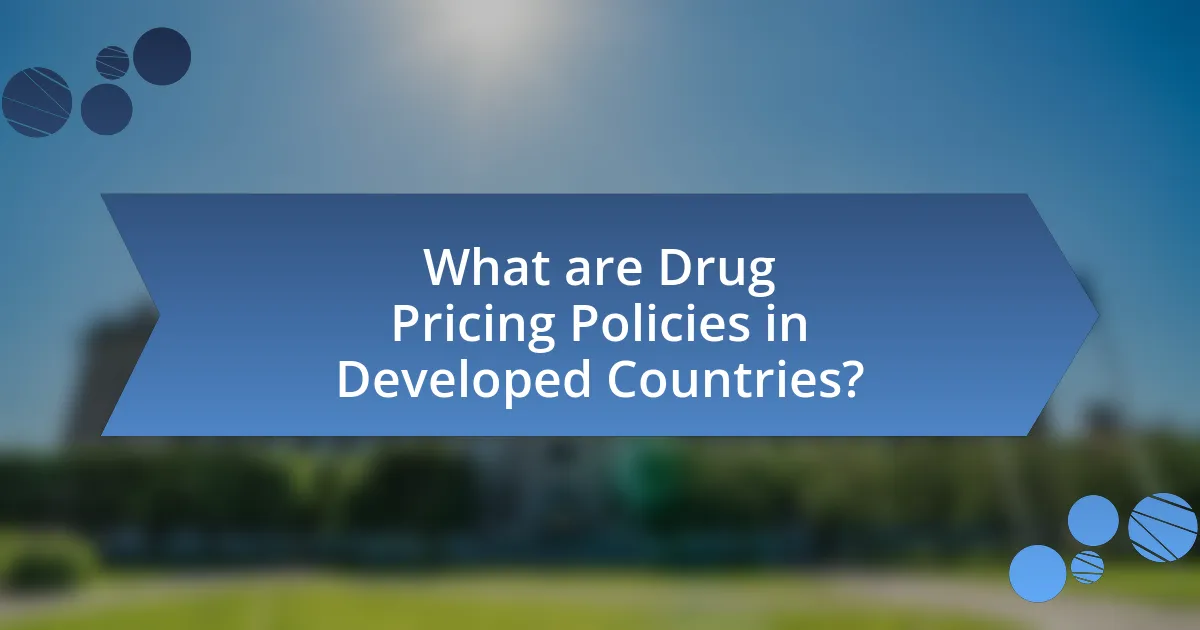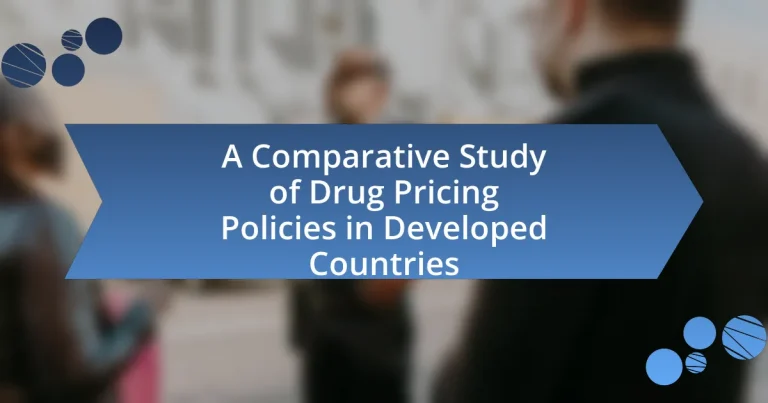The article provides a comparative analysis of drug pricing policies in developed countries, highlighting the regulatory frameworks that govern pharmaceutical pricing and access to medications. It examines the diverse approaches taken by countries such as Canada, the United Kingdom, and the United States, focusing on factors like price controls, negotiation strategies, and market dynamics that influence drug affordability. Additionally, the article discusses the implications of these policies on patient access, healthcare costs, and the prescribing behavior of healthcare professionals, while also addressing the role of cultural attitudes and stakeholder engagement in shaping effective pricing strategies. Key components such as health technology assessments and the impact of pricing strategies on innovation are also explored, offering insights into best practices for improving drug pricing frameworks globally.

What are Drug Pricing Policies in Developed Countries?
Drug pricing policies in developed countries are regulatory frameworks designed to control the prices of pharmaceuticals and ensure access to medications. These policies vary significantly across countries, with some implementing price controls, reference pricing, or negotiation strategies to manage costs. For instance, countries like Canada utilize a Patented Medicine Prices Review Board to assess and regulate the prices of new drugs, while the United Kingdom employs the National Institute for Health and Care Excellence to evaluate cost-effectiveness and negotiate prices with manufacturers. In contrast, the United States primarily relies on market forces, with limited government intervention, leading to higher drug prices compared to other developed nations. These diverse approaches reflect differing healthcare priorities and economic conditions, impacting drug affordability and accessibility for patients.
How do drug pricing policies vary across different developed countries?
Drug pricing policies vary significantly across developed countries due to differing regulatory frameworks, market dynamics, and healthcare systems. For instance, countries like Canada and the United Kingdom employ price controls and negotiation strategies to keep drug costs lower, with the National Health Service in the UK negotiating prices directly with manufacturers. In contrast, the United States largely relies on market forces, resulting in higher drug prices, as there are fewer regulations on pricing and no centralized negotiation process. Additionally, countries such as Germany utilize an “AMNOG” system, where new drugs undergo an assessment for added value before pricing negotiations, leading to varied outcomes based on therapeutic benefit. These differences illustrate how each country’s approach to drug pricing reflects its healthcare priorities and economic strategies.
What factors influence the differences in drug pricing policies?
Differences in drug pricing policies are influenced by factors such as regulatory frameworks, market dynamics, healthcare systems, and negotiation practices. Regulatory frameworks vary significantly across countries, affecting how drug prices are set and adjusted; for instance, some countries have price controls while others rely on free market principles. Market dynamics, including competition among pharmaceutical companies and the availability of generics, also play a crucial role in determining prices. Additionally, the structure of healthcare systems, such as whether they are publicly funded or privately operated, impacts how drugs are priced and reimbursed. Negotiation practices between governments, insurers, and pharmaceutical companies further contribute to the variability in drug pricing policies, as seen in countries like Canada, where the Patented Medicine Prices Review Board regulates prices, compared to the United States, where prices are often negotiated individually.
How do cultural attitudes towards healthcare affect drug pricing?
Cultural attitudes towards healthcare significantly influence drug pricing by shaping public expectations, government policies, and market dynamics. For instance, in countries where healthcare is viewed as a universal right, such as in many European nations, governments often implement price controls and negotiate directly with pharmaceutical companies to keep drug costs low. This contrasts with countries like the United States, where a more market-driven approach prevails, leading to higher drug prices due to less regulation and a focus on profit maximization. Research indicates that in the U.S., the average price of prescription drugs is substantially higher than in countries with more collectivist healthcare models, with some studies showing prices up to four times greater. Thus, cultural perceptions of healthcare directly correlate with the regulatory frameworks and pricing strategies employed in different nations.
Why are drug pricing policies important for healthcare systems?
Drug pricing policies are crucial for healthcare systems because they directly influence the affordability and accessibility of medications for patients. Effective drug pricing policies can help control healthcare costs, ensuring that essential medications remain within reach for the population. For instance, countries with stringent drug pricing regulations, such as Canada, often report lower drug expenditures per capita compared to those with less regulated markets, like the United States, where prices can be significantly higher. This disparity highlights the importance of drug pricing policies in maintaining equitable healthcare access and managing overall healthcare spending.
What impact do drug pricing policies have on patient access to medications?
Drug pricing policies significantly affect patient access to medications by determining the affordability and availability of essential drugs. For instance, high drug prices can lead to increased out-of-pocket costs for patients, resulting in reduced adherence to prescribed treatments. A study published in the Journal of the American Medical Association found that nearly 25% of patients reported not filling prescriptions due to cost concerns. Additionally, countries with stringent pricing regulations, such as Canada, often report higher medication access rates compared to those with less regulated markets, illustrating the direct correlation between pricing policies and patient access.
How do these policies affect overall healthcare costs?
Drug pricing policies significantly impact overall healthcare costs by influencing the prices of medications, which constitute a substantial portion of healthcare expenditures. For instance, countries with stringent drug pricing regulations, such as those in Europe, often report lower pharmaceutical spending compared to countries like the United States, where prices are less regulated. A study published in the Journal of the American Medical Association found that the U.S. spends approximately $1,200 per capita on prescription drugs, while countries with price controls spend around $600 per capita. This discrepancy illustrates how effective drug pricing policies can lead to reduced overall healthcare costs by lowering the financial burden of medications on both consumers and healthcare systems.

What are the Key Components of Drug Pricing Policies?
The key components of drug pricing policies include cost-effectiveness analysis, negotiation mechanisms, transparency requirements, and regulatory frameworks. Cost-effectiveness analysis evaluates the value of a drug relative to its price, ensuring that healthcare systems allocate resources efficiently. Negotiation mechanisms allow governments or insurers to negotiate prices with pharmaceutical companies, which can lead to lower costs for consumers. Transparency requirements mandate that drug manufacturers disclose pricing information and the rationale behind price increases, fostering accountability. Regulatory frameworks establish guidelines and standards for pricing practices, ensuring compliance and protecting public health interests. These components collectively aim to balance access to medications with the sustainability of healthcare systems in developed countries.
What methods are used to determine drug prices in developed countries?
Drug prices in developed countries are determined through various methods, including cost-effectiveness analysis, reference pricing, and negotiation with pharmaceutical companies. Cost-effectiveness analysis evaluates the economic value of a drug relative to its health benefits, guiding pricing decisions based on the balance of cost and therapeutic effectiveness. Reference pricing involves setting a price based on the prices of similar drugs in other countries, ensuring that prices remain competitive and affordable. Additionally, many governments negotiate directly with pharmaceutical companies to establish prices, often leveraging bulk purchasing agreements to lower costs. These methods are supported by data from health economics studies and government reports, which highlight their effectiveness in managing drug expenditures while ensuring access to necessary medications.
How do negotiation processes between governments and pharmaceutical companies work?
Negotiation processes between governments and pharmaceutical companies typically involve discussions on drug pricing, access, and reimbursement terms. Governments aim to secure lower prices and ensure public health access, while pharmaceutical companies seek to protect their profit margins and recover research and development costs.
These negotiations often include assessments of the drug’s clinical effectiveness, cost-effectiveness analyses, and comparisons with existing treatments. For instance, in countries like Canada and the UK, agencies such as the Canadian Agency for Drugs and Technologies in Health and the National Institute for Health and Care Excellence evaluate new drugs before negotiations begin, providing a framework for discussions.
Additionally, the negotiation outcomes can be influenced by public health policies, budget constraints, and the overall economic environment. In 2020, the UK’s National Health Service negotiated a deal with the pharmaceutical company Novartis for the drug Zolgensma, which resulted in a significant price reduction, demonstrating how negotiations can lead to more favorable terms for governments.
What role do health technology assessments play in pricing decisions?
Health technology assessments (HTAs) play a critical role in informing pricing decisions for pharmaceuticals and medical technologies. HTAs evaluate the clinical effectiveness, cost-effectiveness, and overall value of health interventions, providing evidence that helps policymakers and payers determine appropriate pricing levels. For instance, countries like the United Kingdom utilize HTAs conducted by organizations such as the National Institute for Health and Care Excellence (NICE) to assess whether a drug’s benefits justify its cost, influencing reimbursement decisions and market access. This evidence-based approach ensures that pricing aligns with the therapeutic value provided to patients and the healthcare system, ultimately guiding resource allocation in a manner that maximizes health outcomes.
What are the implications of different pricing strategies?
Different pricing strategies significantly impact market access, revenue generation, and consumer behavior in the pharmaceutical industry. For instance, value-based pricing aligns drug prices with the therapeutic benefits they provide, potentially increasing patient access and adherence while maximizing revenue for manufacturers. Conversely, cost-plus pricing may lead to higher prices that limit access, particularly in low-income populations, as seen in various developed countries where healthcare systems prioritize affordability. Additionally, tiered pricing strategies can enhance access in different markets by adjusting prices based on economic conditions, which has been effective in countries like Canada and Germany. These implications highlight the need for careful consideration of pricing strategies to balance profitability with public health objectives.
How do reference pricing and external price referencing impact drug costs?
Reference pricing and external price referencing significantly lower drug costs by establishing a benchmark for pricing based on the prices of similar drugs in other markets. Reference pricing allows health insurers to set a maximum reimbursement level for a drug, encouraging competition among manufacturers to lower their prices to meet this benchmark. For instance, in countries like Germany and the Netherlands, reference pricing has led to substantial price reductions, with some studies indicating savings of up to 30% on certain medications. External price referencing, which involves comparing drug prices across different countries, further pressures manufacturers to align their prices with those in lower-cost markets, thereby reducing overall drug expenditures. This approach has been shown to enhance affordability and accessibility of medications in various healthcare systems.
What are the consequences of price controls on innovation in pharmaceuticals?
Price controls on pharmaceuticals typically lead to reduced innovation in the industry. When governments impose price caps, pharmaceutical companies often experience decreased revenue, which can limit their ability to invest in research and development. For instance, a study by the National Bureau of Economic Research found that countries with stringent price controls tend to have fewer new drug approvals compared to those with more flexible pricing, indicating a direct correlation between price regulation and innovation output. Additionally, the Pharmaceutical Research and Manufacturers of America reported that the average cost to develop a new drug exceeds $2.6 billion, highlighting the financial risks involved in drug development that price controls can exacerbate.

How do Drug Pricing Policies Affect Patients and Healthcare Providers?
Drug pricing policies significantly impact both patients and healthcare providers by influencing medication affordability and access. For patients, high drug prices can lead to increased out-of-pocket costs, resulting in medication non-adherence; studies show that nearly 25% of patients skip doses or do not fill prescriptions due to cost concerns. Healthcare providers face challenges as well, as high drug prices can strain budgets and limit treatment options, ultimately affecting patient care quality. For instance, a report from the American Hospital Association indicates that hospitals often absorb high drug costs, which can lead to reduced resources for patient services. Thus, drug pricing policies directly shape the healthcare landscape by affecting both patient health outcomes and the operational capabilities of healthcare providers.
What challenges do patients face due to drug pricing policies?
Patients face significant challenges due to drug pricing policies, primarily including high out-of-pocket costs and limited access to necessary medications. High prices can lead to financial strain, forcing patients to choose between essential medications and other basic needs. For instance, a study published in the Journal of the American Medical Association found that nearly 25% of Americans reported not filling a prescription due to cost concerns. Additionally, drug pricing policies can create disparities in access, particularly for low-income individuals and those without insurance, exacerbating health inequities. These challenges highlight the critical impact of drug pricing on patient health outcomes and financial stability.
How do high drug prices influence patient adherence to treatment?
High drug prices negatively influence patient adherence to treatment by making medications unaffordable for many individuals. When patients face high out-of-pocket costs, they are more likely to skip doses, reduce their medication intake, or abandon treatment altogether. A study published in the Journal of Managed Care & Specialty Pharmacy found that nearly 25% of patients reported not filling prescriptions due to high costs, which directly correlates with poorer health outcomes and increased hospitalizations. This demonstrates that financial barriers significantly hinder adherence, ultimately affecting overall public health.
What are the financial burdens on patients in different developed countries?
Patients in different developed countries face varying financial burdens primarily due to differences in healthcare systems, insurance coverage, and drug pricing policies. In the United States, patients often encounter high out-of-pocket costs, with approximately 20% of adults reporting difficulty in affording medications, largely due to high prices and limited insurance coverage. In contrast, countries like Canada and the United Kingdom have more regulated drug pricing, resulting in lower out-of-pocket expenses for patients; for instance, Canada’s Patented Medicine Prices Review Board ensures that drug prices are not excessive, leading to lower financial burdens. Meanwhile, in Germany, patients benefit from a statutory health insurance system that caps co-payments, significantly reducing their financial strain. Overall, the financial burdens on patients are influenced by the structure of healthcare systems and the effectiveness of drug pricing regulations in each country.
How do healthcare providers navigate drug pricing policies?
Healthcare providers navigate drug pricing policies by employing strategies such as formulary management, negotiation with pharmaceutical companies, and adherence to regulatory frameworks. Formulary management allows providers to select medications based on cost-effectiveness and clinical efficacy, ensuring that patients receive the most appropriate treatments while controlling expenses. Negotiation with pharmaceutical companies can lead to discounts or rebates, which help lower the overall cost of medications for healthcare systems. Additionally, providers must comply with regulatory frameworks that govern drug pricing, such as price transparency laws and reimbursement policies, which influence their purchasing decisions and patient access to medications. These strategies are essential for maintaining financial sustainability while delivering quality care.
What strategies do providers use to manage drug costs for patients?
Providers use several strategies to manage drug costs for patients, including negotiating prices with pharmaceutical companies, utilizing generic medications, and implementing patient assistance programs. Negotiating prices allows providers to secure lower costs for medications, which can directly reduce patient expenses. The use of generic medications, which are often significantly cheaper than their brand-name counterparts, further helps in minimizing costs. Additionally, patient assistance programs offer financial support or subsidized medications to eligible patients, ensuring access to necessary treatments without overwhelming financial burden. These strategies are essential in addressing the rising costs of pharmaceuticals and improving patient affordability in healthcare systems.
How do pricing policies affect the prescribing behavior of healthcare professionals?
Pricing policies significantly influence the prescribing behavior of healthcare professionals by determining the affordability and accessibility of medications. When drug prices are high due to stringent pricing policies, healthcare professionals may prescribe fewer brand-name medications and opt for generics or alternative treatments to manage costs for patients. For instance, a study published in the Journal of Health Economics found that in countries with strict price controls, such as Canada, physicians tend to prescribe generics more frequently compared to those in the United States, where prices are less regulated. This shift in prescribing patterns is driven by the need to balance patient care with economic considerations, ultimately affecting treatment outcomes and patient adherence to prescribed therapies.
What Best Practices Can Be Adopted for Effective Drug Pricing Policies?
Effective drug pricing policies can be achieved through transparency, value-based pricing, and stakeholder engagement. Transparency in pricing allows consumers and healthcare providers to understand drug costs, fostering competition and accountability. Value-based pricing aligns drug prices with the therapeutic benefits they provide, ensuring that patients receive fair value for their medications. Stakeholder engagement, including input from patients, healthcare professionals, and policymakers, ensures that diverse perspectives are considered, leading to more equitable pricing strategies. These practices have been shown to improve access to medications and enhance overall healthcare outcomes in various developed countries.
How can countries learn from each other’s drug pricing strategies?
Countries can learn from each other’s drug pricing strategies by analyzing and adopting best practices that have proven effective in different healthcare systems. For instance, countries like Canada utilize a reference pricing system, where drug prices are compared to those in other countries, allowing for more competitive pricing. This approach has led to lower costs for consumers while maintaining access to essential medications. Additionally, countries can share data on the impact of various pricing models, such as value-based pricing, which ties the cost of drugs to their therapeutic benefits, as seen in the United Kingdom. By collaborating on research and policy frameworks, nations can identify successful strategies and adapt them to their unique contexts, ultimately improving affordability and access to medications.
What role do patient advocacy groups play in shaping drug pricing policies?
Patient advocacy groups play a crucial role in shaping drug pricing policies by influencing legislation and public opinion. These organizations represent the interests of patients, often mobilizing grassroots campaigns to advocate for affordable medications and transparency in pricing. For instance, advocacy groups have successfully lobbied for policies that require pharmaceutical companies to disclose pricing information and have pushed for the implementation of price negotiation mechanisms in various countries. Their efforts can lead to significant changes in drug pricing frameworks, as seen in the United States with the Affordable Care Act, which included provisions influenced by patient advocacy to improve access to medications.


